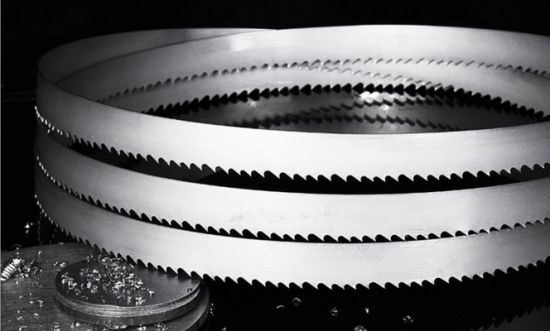1.Band blade width
The width of a blade is the measurement from the top of the tooth to the back edge of the blade. The wider blades are stiffer overall (more metal) and tend to track better on the band wheels than narrow blades. When cutting thicker material, the wider blade has less ability to deviate because the back end, when in the cut, helps steer the front of the blade, especially if the side clearance is not excessive. (As a point of reference, we might call a blade that is 1/4 to 3/8 inch in width a "medium width" blade.)
Special note: When resawing a piece of wood (that is, making it into two pieces half as thick as the original), the narrower blade will actually cut straighter than a wider blade. The force of cutting will make a wide blade deviate sideways, while with a narrow blade, the force will push it backwards, but not sideways. This is not what might be expected, but it is indeed true.
Narrow blades can, when cutting a curve, cut a much smaller radius curve than a wide blade. For example, a ¾-inch- wide blade can cut a 5-1/2-inch radius (approximately) while a 3/16-inch blade can cut a 5/16-inch radius (about the size of a dime). (Note: The kerf determines the radius, so these two examples are typical values. A wider kerf, meaning more sawdust and a wider slot, allows smaller radius cuts than with a narrow kerf. Yet a wider kerf means that the straight cuts will be rougher and have more wandering.)
When sawing hardwoods and high density softwoods like Southern yellow pine, it is my preference to use as wide a blade as possible; low density wood can use a narrower blade, if desired.
2.Band blade thickness
In general, the thicker the blade, the more tension that can be applied. Thicker blades are also wider blades. More tension means straighter cuts. However, thicker blades mean more sawdust. Thicker blades are also more difficult to bend around the band wheels, so most manufacturers of bandsaws will specify a thickness or thickness range. Smaller diameter band wheels need thinner blades. For example, a 12-inch diameter wheel is often equipped with a 0.025-inch thickness (maximum) blade that is ½ inch or narrower. An 18-inch diameter wheel can use a 0.032-inch thick blade that is ¾ inch wide.
In general, thicker and wider blades will be the choice when sawing dense wood and woods with hard knots. Such wood needs the extra strength of a thicker, wide blade to avoid breaking. Thicker blades also deflect less when resawing.















